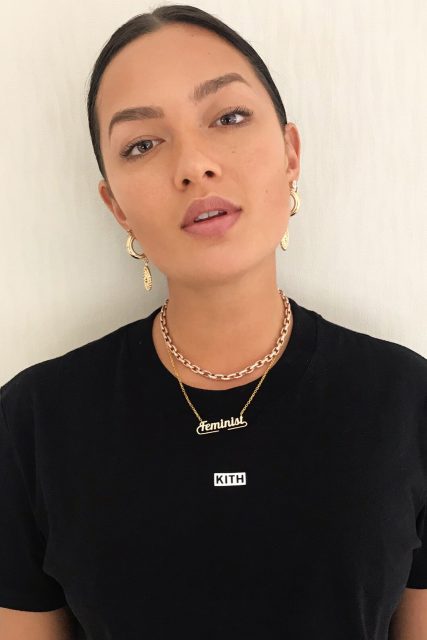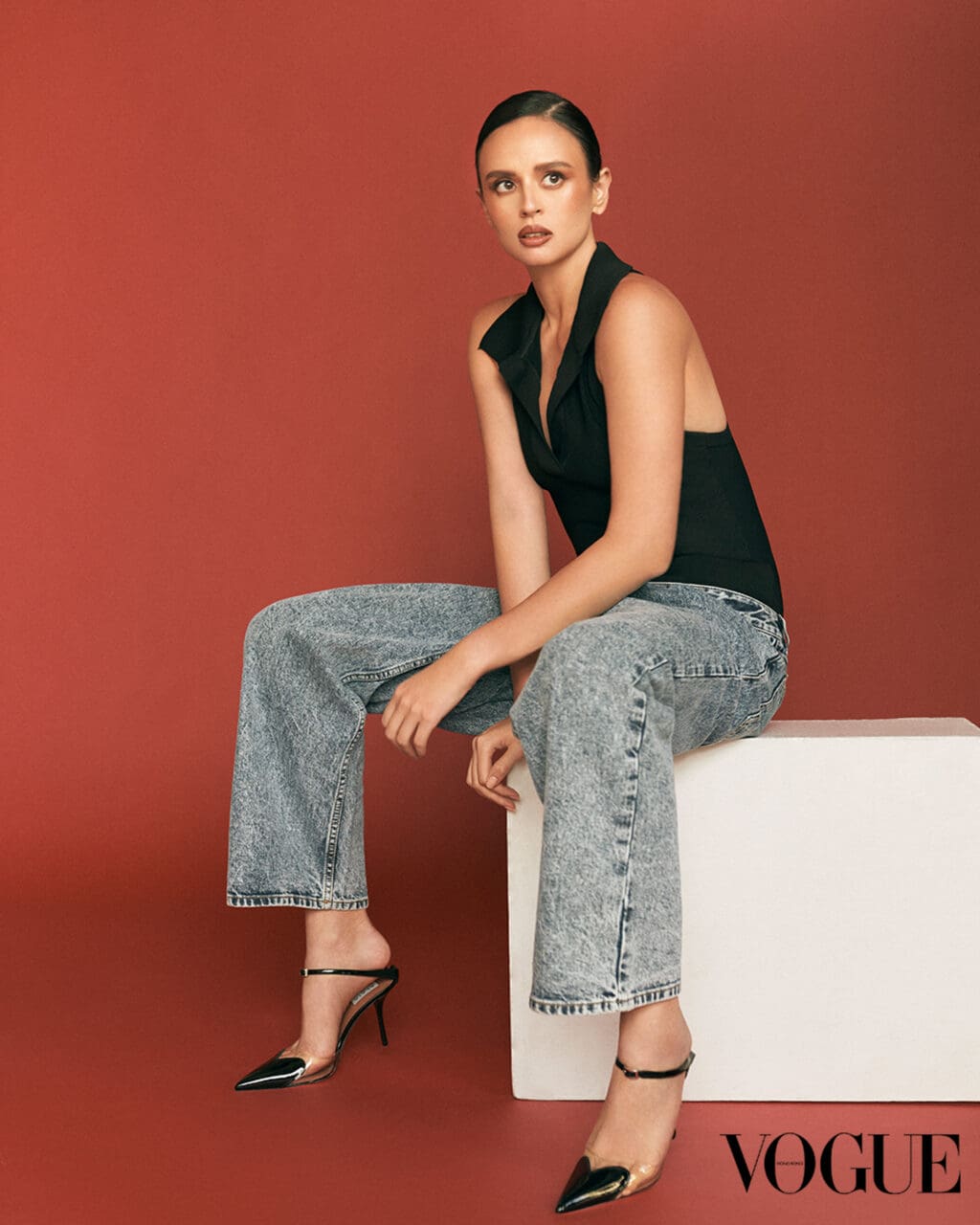To say I’ve had my struggles with sizing is an understatement. With a body that runs a spectrum of sizes (UK 10 to 14 depending on the part in question, the time of the month and how long I’ve spent in lockdown), I have a small army of tailors on speed dial – one of whom specialises in taking up hems alone – and some fairly ingrained dysmorphic tendencies to boot.
Imagine my delight (during what has become a disturbingly regular practice of TikToking at bedtime) when I began to notice more and more women with similar sizing issues, with body shapes that, while so familiar to mine, I was not used to seeing beyond the mirror. Women whose clothing sizes ran on the smaller side of the body-positive warriors I was used to seeing in my feed, and on the larger side than of the standard fashion influencers. In short, bodies just like mine, with the same woes, all tagged with a term I’d also never seen before: ‘mid-size’.
Sitting between ‘straight-size’ (the industry term for standard sizing that falls between UK 6 to 10) and ‘plus-size’ (UK 18 and over), ‘mid-size’ spans UK 12-18. The average woman in the UK and Europe is a UK 16, or EU 44. Yet, the mid-size woman is something of a silent majority: less than 20 per cent of apparel is made for her and she has little representation in fashion and media.
Now, the increasingly vocal voices of the middle ground are seeking to be part of the conversation around body inclusivity via TikTok; a platform favoured for its rawness over the hyper-perfection of Instagram; its algorithm allowing a greater diversity of people to gain traction regardless of follower count. In other words, if your content speaks to people, you’ll be seen.
View this post on Instagram
Voices of the mid-size ‘middle ground’
“I’m completely in-between sizes,” explains Los Angeles-based mid-size model and body activist Raeann Langas, whose shoppable Instagram posts are tagged with brands including Reformation, With Jéan and Girlfriend Collective. “Reformation’s straight sizes, for example, go up to a US 12 [UK 14, EU 42]. I fit into some of those, but some are too small – then it jumps to plus-size. And the plus-sizes are too big. So there’s a large gap in the sizing chart for a lot of brands.”
View this post on Instagram
Langas’s experiences are echoed by that of Texas-based Californian mid-size model Ali Tate, who began her modelling career while studying in London as a size-UK 10 teenager. “My size typically has not worked,” says Tate, who favours brands such as Agolde, Rails, Staud and Orseund Iris. “[Mid-size models] always had to either lose weight or gain weight to work. Fashion always gravitates towards extremes and it’s so interesting because the majority of my friends are my size and have never seen anyone that reflected them in pictures.” While a size-six model “doesn’t look like me at all,” she explains, “plus-size is clearer but still doesn’t truly reflect my body shape or size.”
“There is definitely a fight that needs to happen for women size [US] 16 and up,” Tate adds. “But if we’re asking for inclusivity, let’s not leave out mid-size. We need to see the full spectrum of what it is to be human. I was a US size 10 and massively struggled with eating disorders and body image issues. Folks are still dealing with these issues, even being mid-size.”
British mid-size stylist Karina Marriott, meanwhile, recognises that there is a privilege to be able to go into straight-size stores and find her size. “Mid-size should not be a movement distanced from the plus-size community,” she says. “I didn’t know where I fit in because I wasn’t slim or plus-sized. Mid-size is a really useful term when it comes to finding women who have a similar shape or body type to me.”
View this post on Instagram
A sizing system that actually works
Despite all the progress that’s been made in size diversity on the runway in recent years, autumn/winter 2021 saw a downward slide with just 19 plus-size castings versus spring/summer 2020’s all-time high of 86. “We’ve had this weird idea in luxury ready-to-wear, whether you’re sample-size, straight-size or not; it’s more about design and concept than comfort,” explains Vanja Hedberg, an alumnus of Margiela, Lanvin, and Balenciaga and the director of MA fashion design at Institut Français de la Mode in Paris.
Hedberg describes how most in-store sizes originate from patterns cut for the runway. In a process known as ‘normalisation’, these patterns are then adjusted to fit standardized EU 38 or 40, forming a basis that is then graded up or down. “You can’t just take a pattern and blow it up because the proportions change,” she says. “It’s a finely tuned and complex mathematical process that has been industrialised. So, perhaps, there needs to be a deeper change to how we design, with more love towards the female experience and the female body.”
View this post on Instagram
Some designers, though, are developing innovative solutions to provide women with their true size. In 2018, Chromat – the New York label founded by Becca McCharen-Tran – overhauled its pattern archive and sizing structure. To prepare for the launch of a range that runs to XXXL, they hosted a four-day, open-door sizing initiative, which saw them fit over 500 women of all sizes. Berlin-based Business IT student and mid-size fashion influencer Lois Opoku believes McCharen-Tran’s approach is the future. “Designers and brands should check the data on women – that could be my tech experience talking,” she smiles. “It’s hard to understand that you see how people look on the street and you still have a sizing system that doesn’t fit society and the women who are supposed to buy the clothes.”
True Fit, a data-driven personalisation platform that works with retailers including Levi’s, Ralph Lauren and Ugg, has developed the Fashion Genome – the footwear and apparel industry’s most comprehensive data set, gathered from nearly 200 million people throughout the US, UK and Europe. “Overall, when we talk to our clients, the amount of growth they’re seeing in this size range is causing some of them to start blurring the lines between standard and plus sizes,” explains a True Fit representative. Their findings have implied that brands are now thinking about sizing in terms of a wide range continuum, as opposed to rigid segments such as ‘standard’ and ‘plus-size’.
For Tate, a hopeful future comes with celebrating progress already made. “We have to acknowledge how far we’ve come, even in the 10 years that I’ve been in the industry,” she muses. “Curve models landing covers of huge magazines, big editorials and fashion shows – this shit was just not around when I started. My stance would be quite positive upon reflection and acknowledging that, as with anything, there’s always more we can do.”
Editor
Divya Bala





